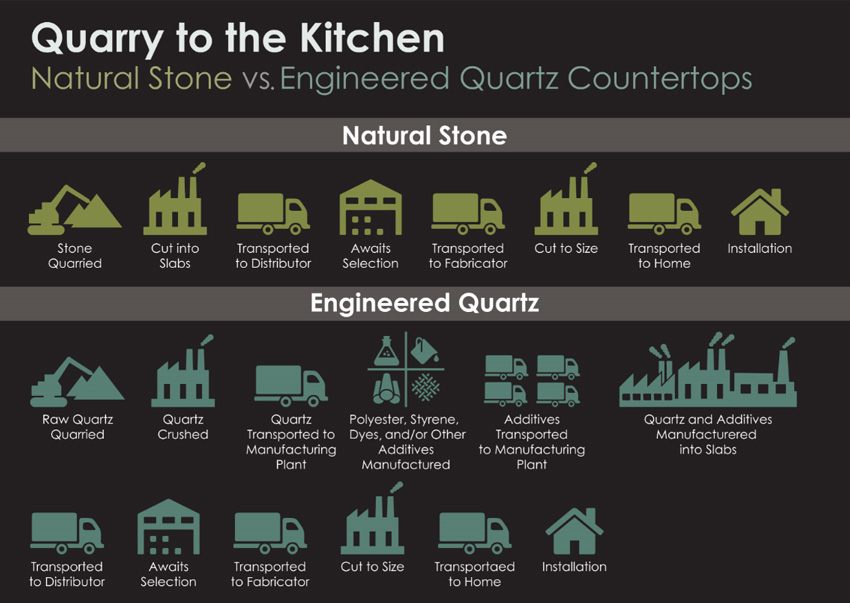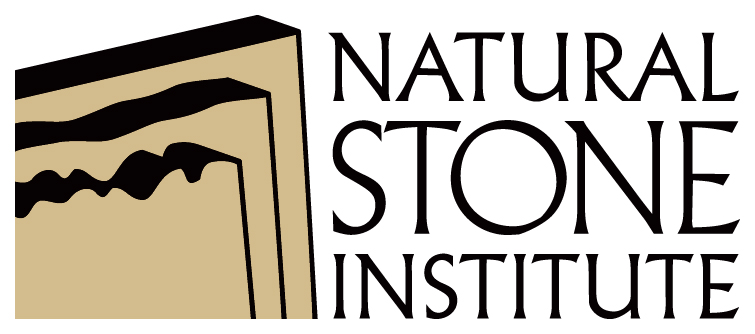Natural Stone Fact vs. Myth: Addressing Common Misconceptions
The Sustainability Standard
In 2014, the natural stone industry established the sustainable stone certification standard. ANSI 373: Sustainable Production of Natural Dimension Stone provides natural stone quarriers and fabricators with third-party verification of their sustainable practices. The standard also allows builders and designers to confidently specify stone as a sustainable material. Finally, the standard will help drive continual improvement in the industry as preference is shown to products that have been certified as sustainable.
ANSI 373-2019 applies to all processors of natural stone, from quarry operations to final stone fabricators. The standard utilizes a point-based system with both required and optional criteria in 10 categories. Certification is based on point totals and includes four tiers of certification: Bronze, Silver, Gold, and Platinum. Operations must be monitored and reevaluated periodically to maintain their certification. The chain-of-custody (COC) standard complements the sustainability standard. Its aim is to drive sustainability throughout the supply chain, ensuring that natural stone products that are produced with best practices are also handled throughout the supply chain in a manner that ensures and upholds their sustainability.
The 10 categories in ANSI 373-2019 are:
Water: minimal freshwater use in processing and ensuring good quality of water being released back to the environment
Energy: energy-efficient operations with low carbon impacts
Custody & Transportation: efficiency of the transportation and handling of stone
Chain of Custody: an unbroken chain of certified organizations from quarry to the end user
Chemicals & Materials: safe management of chemicals within operations and avoidance of Red List chemicals
Excess Materials: low amounts of excess processed material and solid waste that goes into landfills
Innovation: promoting continuous improvement and transformation of the industry
Site Management: site-specific measurement plans to ensure responsible management of environmental impacts
Land Reclamation: responsible and sustainable reclamation of quarry sites once operations have ceased
Human Health & Safety: plans to ensure that workers are provided with a safe and healthy work environment
Corporate Governance: social responsibility through workplace regulations and employee/community programs
Green Building Programs
ANSI 373 was updated in 2019 to align with evolving green building programs, such as the U.S. Green Building Council’s Leadership in Energy and Environmental Design (LEED) and the International Living Future Institute's Living Building Challenge.
These changes are helping designers and project teams meet their sustainability goals. Let us examine how certified natural stone products can contribute to these goals.
LEED v4
In LEED v4, certified natural stone can contribute to Option 1 under the credit Building Product Disclosure and Optimization: Sourcing of Raw Materials, provided that the facility and/or quarry operation has earned certification, including either optional credit 7.2.1: Ecosystem Boundaries or 7.2.2: Environmental Impact Assessment. This option, found under the Material Resources category, requires the use of at least 20 different permanently installed products from at least five different manufacturers “that have publicly released a report from their raw material suppliers that includes raw material supplier extraction locations, a commitment to long-term ecologically responsible land use, a commitment to reducing environmental harms from extraction and/or manufacturing processes, and a commitment to meeting applicable standards or programs voluntarily that address responsible sourcing criteria.”
In addition, natural stone that has earned an approved label such as Declare may contribute to Option 1: Material Ingredient Reporting under the credit Building Product Disclosure and Optimization: Material Ingredients. This option requires that the project use at least 20 different permanently installed products from at least five different manufacturers that use a USGBC-approved program to demonstrate the chemical inventory of the product to at least 0.1 percent (1,000 ppm). Material ingredient reporting uses a wide range of programs, including Cradle to Cradle and health product declarations (HPDs). Since natural stone is composed of a single (and natural) ingredient, it is an easy product to document.
Living Building Challenge
The Living Building Challenge has been instrumental in pushing the building industry toward a more holistic approach to green building. It consists of seven categories, called Petals, which address various aspects of a healthy, sustainable building. The Materials Petal strives to “help create a materials economy that is nontoxic, ecologically restorative, transparent, and socially equitable.” Under the Materials Petal, the Responsible Industry Imperative requires that project teams advocate for the creation and adoption of third-party-certified standards for sustainable resource extraction and fair labor practices. For stone, project teams must advocate to quarries and/or manufacturers of all dimension stone products used within the project for certification under ANSI 373.
In addition, natural stone is supportive of several other Imperatives, including the Biophilic Environment and Healthy Indoor Environment, which both fall under the Health & Happiness Petal.
The Scoop on Quarries and Fabricators
The natural stone industry has long been committed to sustainable practices. That said, quarrying and processing operations are not without impacts. Choosing certified stone can help ensure that you are rewarding sustainable operations while meeting the “green” goals of your project.
In addition to its sustainability standard, the Natural Stone Council publishes best practices for transportation, solid waste management, water management, and quarry site management. Unfortunately, many people equate quarrying with mining and are unaware of the best practices that are employed by many quarries and fabricators.
Most natural stone quarries have a small footprint and operate in the same location for decades. In most modern quarries, the stone is meticulously extracted with little to no blasting, as this can fracture the stone. Quarries strive to minimize waste and utilize most if not all of the extracted stone, often finding creative ways to divert “waste” into new income streams. In some cases, donating or recycling scrap is possible.
As noted earlier, transportation energy can be significant, as stone is incredibly dense, or “heavy.” Industry best practices range from centralizing freight management to choosing carriers that use fuel-efficient vehicles, and even switching to reusable and non-plastic packing materials. All of these strategies not only help reduce the environmental impact of transportation but also save the operation money.
ANSI 373 encourages quarry operators and fabricators to minimize freshwater consumption and ensure the quality of water released back to the environment. Operators must develop and maintain an annual water inventory, and recapture and recycle a minimum of 25 percent of the total water used. In fact, some operations recycle far more than that.
Most quarries will have plans in place that seek to limit habitat loss, waterway damage, erosion, pollution, noise, and vibrations. In addition, they will have a reclamation plan to guide rehabilitation of the site once the operation is closed. ANSI 373 requires that certified quarries develop such plans; many states also require them. According to ANSI 373, plans should include proposals for site cleanup, infrastructure renewal, site safety, and ecosystem restoration. It is also recommended that stone companies work with the original landowners or the local community when developing their plans.
Even before the sustainability standard was developed, many shuttered quarries have been converted into parks and reservoirs.
The 684-acre Quarry Park and Nature Preserve located just outside of St. Cloud, Minnesota, provides a compelling example of how a once-productive quarry has been reclaimed as an attractive recreation destination. In summer, people flock to the quarry to swim, picnic, hike, fish, and rock climb; in winter, cross-country skiing and snowshoeing are popular. From the 1880s to the 1960s, several stone companies operated quarries in present-day Quarry Park, which opened to the public in 1992.
Other creative uses for old quarries include golf courses, amusement parks, housing developments, and shooting ranges.

Image courtesy of Natural Stone Institute
Engineered quartz has greater embodied energy than natural stone because there are many more steps in the manufacturing process.
Conclusion
Natural stone is a beautiful, versatile material with many possible applications, both inside and out. In addition to lending a timeless quality to building projects, natural stone is a key component in biophilic design. Natural stone elements can help create a serene, warm environment that promotes well-being and supports health. Unfortunately, some clients are reluctant to specify natural stone out of concern for its cost, maintenance requirements, and sustainability. As design professionals, you can help clear up these misconceptions, guiding clients to select stone products that are appropriate for the application—and that with the proper care will last for decades. In addition, you can show them how natural stone can help them attain their sustainability goals while lowering the overall environmental impacts of the construction and operation of their buildings.
 |
The Natural Stone Institute offers a wide array of technical and training resources, professional development, regulatory advocacy, and networking events for the natural stone industry. Learn more at www.naturalstoneinstitute.org/stoneacademy. |









